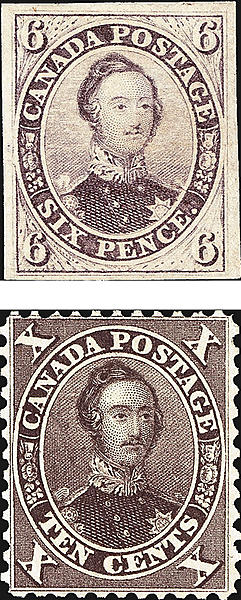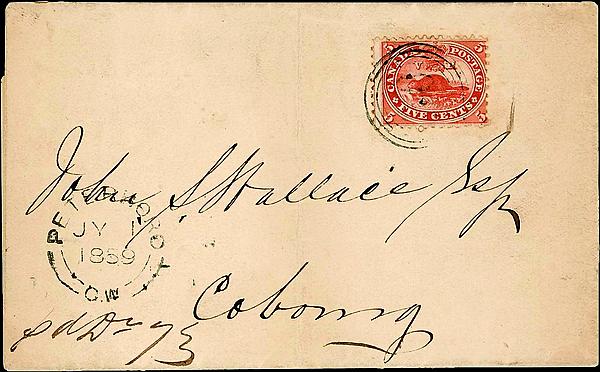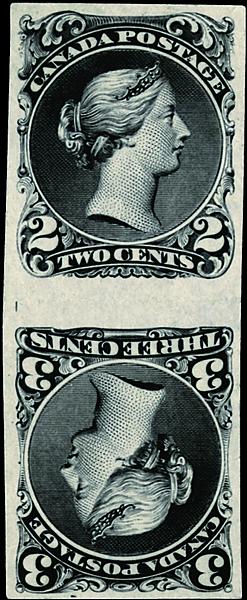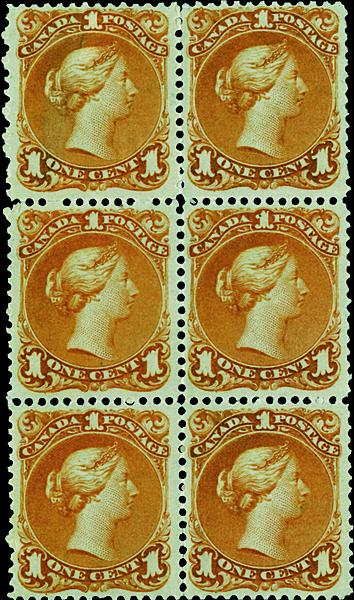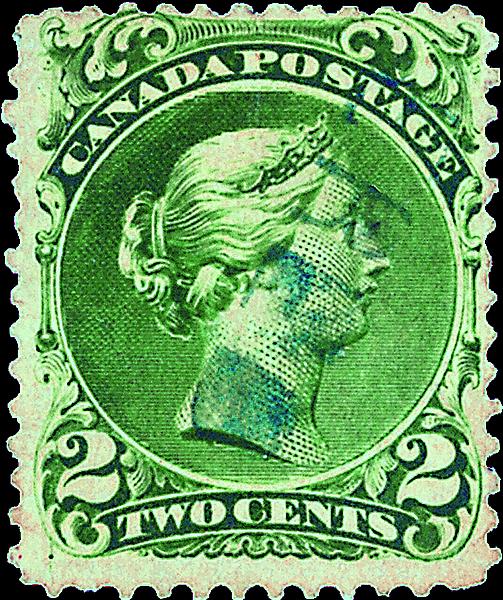Auctions
Canada dominates February auction news
If January was all about China, the philatelic spotlight in February turned instead to Canada.
The first part of the Brigham Collection, widely acknowledged to be one of the greatest collections of Canadian stamps ever assembled, was offered Feb. 22 in a suburb of Toronto.
The sale, comprising the so-called Large Queen issue of 1868-97, was previewed in Linn’s Feb. 17 issue.
The collection of Ron Brigham, a Canadian businessman and philatelist, has won many international awards, and his “Pence and Cents” exhibit has been the only collection of Canadian stamps to have won philately’s highest prize, the Grand Prix d’Honneur, which it received in Belgium in 2001.
Brigham organized the sale himself through his firm, Brigham Auctions, in partnership with the German firm of Christoph Gaertner.
Browsing the catalog, available online at brighamauctions.com, is like peeking into a Canadian philatelic hall of fame.
Tracy Shreve called the lots on an auction floor she described as “crowded.” The auction was also broadcast live online via Stamp Auction Network, a website that allows bidders around the world to participate in real time.
“We are delighted with the results of the sale,” said Charles Verge, the CEO of Brigham auctions, when it was done.
The item causing the greatest excitement, shown in Figure 1, was a rare 1868 2¢ green Large Queen on laid paper (Scott 32), lightly canceled in blue. Until the recent discovery of a third example, it was one of just two known, and therefore the capstone to Brigham’s complete collection of Canadian stamps.
One of the challenging aspects of the Large Queens is that they were produced on about 10 different varieties of paper.
Most were of a type known as wove paper, in which the fibers often form a visible grid, but a few stamps — only a very few, in the case of the 2¢ — were printed on paper made by laying down the pulp in such a way that a pattern of horizontal (or vertical) laid lines results.
Before the sale, Brigham predicted that his 2¢ on laid paper, which he described as “the finest and most presentable” of the three known, could reach a new record price for a Canadian stamp.
As it turned out, all bids for the item were submitted in advance, and there was no further bidding on the floor.
Shreve hammered it down for $475,000 in Canadian dollars. With Brigham’s 15 percent buyer’s premium, the realization worked out to a little over U.S. $491,000, edging out the apparent previous record of $488,850, paid for a mint 12-penny “Black Empress” (Scott 3) in 2011.
Another highly anticipated item was the unused block of 18 of the 2¢ design printed on wove paper (Scott 24a) showing a watermark with the papermaker’s name, “E. & G. Bothwell/Clutha Mills.”
The great majority of Large Queens are unwatermarked, and even single stamps showing a letter or two are highly sought after — never mind a block with the full inscription.
Described as the “most important mint multiple in Canadian philately” and the “cornerstone” to any award-winning collection, it sold for about $310,000.
Another unused multiple, a block of six of the 1¢ yellow orange (Scott 23) on a medium-weight paper known as Duckworth paper 10, was called “an altogether mind-numbingly rare world-class rarity of immense importance.”
Hyperbole aside, this original-gum, largest recorded multiple, shown in Figure 2, fetched an impressive $46,500, the third-highest realization in the sale.
An unused 1¢ on laid paper (Scott 31), one of just two or three known with original gum, sold for $36,000. And an imperforate pair of the 5¢ (26b), said to be the item on which the catalog listing is based, sold for just under $29,000.
Die proofs, many of them in beautiful trial colors, added a dramatic extra dimension to the collection. A unique and lovely die proof in deep green of the 15¢ design (Scott 29P — the stamp was issued a range of shades from gray violet to deep blue) sold for $12,400, while a unique compound die proof in black of both the 2¢ and 3¢ (24P, 25P) in a tete-beche arrangement went for $38,800. The tete-beche pair is shown in Figure 3.
An unusual die proof of the 12½¢ stamp (Scott 28P), in black on celluloid, was accompanied by the calling card of the bank note company manager it had originally been purchased from. It sold for $30,000.
Postal history was well represented, as behooves a world-class exhibit collection. A strip of four ½¢ stamps (Scott 21) paid the 2¢ soldier’s rate on an 1868 letter to India, which had been spectacularly (and, happily, incorrectly) inscribed “Dead” and returned to sender. The cover brought over $41,000.
Longley Auctions held a sale Jan. 25 in Hamilton, Ontario, whose highlight was a pretty 1859 cover sent from Peterborough to Cobourg, franked with Canada’s 5¢ vermilion Beaver stamp (Scott 15).
Consisting of a printed form letter from a notary public, the cover, shown in Figure 4, was mailed July 1, 1859, which also happened to be the stamp’s first day of issue and the day Canada abandoned sterling in favor of dollars and cents.
A four-ring “30” numeral cancel ties the stamp, with a clear “Peterboro/C.W.” circular date stamp alongside (Ontario was officially known as Canada West from 1841 to 1867). A Cobourg receiving mark from July 2 is on the back. The cover sold for the equivalent of $16,800, including a 15 percent buyer’s premium.
There were more thrills for collectors of Canada in New York on Jan. 30, when Spink Shreves offered the Joanne and Edward Dauer collection of British North America. This and a simultaneous “Collector’s Series” sale were previewed in Linn’s Jan. 27 issue.
A used example of Canada’s 12-penny black Queen Victoria (Scott 3) with three good margins and a six-ring postmark, was billed as “completely free of faults” — unusually so, as the fragile laid paper is prone to damage. It sold for $46,100, including Spink Shreves’ buyer’s premium of 20 percent on the first $2,000 and 15 percent thereafter.
An unused, fault-free 1857 6d reddish purple Prince Albert stamp on very thick, soft, wove paper (Scott 10), with good margins and crisp, strong color, sold for much more than its value in the 2014 Scott Classic Specialized Catalog of Stamps and Covers 1840-1940, realizing $48,975.
A similar design of 1859, the 10¢ black brown, well centered and with original gum (Scott 16), brought $46,100. Perforated 11¾, it has a sharp impression typical of the stamp’s first printing.
The 6d and the 10¢ stamps are both shown here in Figure 5.
Among provincial issues, an unused Vancouver Island and British Columbia 5¢ rose imperforate of 1865 (Scott 3), probably the finest in existence, sold for $43,225. A similar example, with slightly narrower margins, was offered by the same firm last June (Linn’s, Aug. 19, 2013, page 18) and sold for about one-eighth less. Margins matter.
A scarce provisional airmail stamp of Newfoundland, the 60¢ black overprinted “Air Mail/De Pinedo/1927” in red (Scott C4), sold for $51,850. Still with original gum and just a light hinge mark, it is one of only 33 of the stamps, prepared for the Italian aviator’s pioneer flight, that survive unused.
Francesco De Pinedo, a Neapolitan nobleman who set numerous early long-distance flying records, would be killed in 1933 taking off from Floyd Bennett Field in New York.
A bright rose pink error of the 1946 United States migratory bird hunting permit stamp (Scott RW13a) sold for $11,600, while an unused strip of four of the 1847 5¢ Franklin stamp (Scott 1) brought $5,850.
Spink held a sale in Geneva, Switzerland, Jan. 25 of stamps and postal history from around the world. The star item was an unused, no-gum tete-beche pair of France’s 1-franc light carmine stamp of 1849, in which the left-hand stamp is printed upside-down in error so that the Roman goddess Ceres is facing herself (Scott 9a).
Pairs of tete-beche (French for “head-to-foot”) stamps from this issue are highly prized. The pair in the Spink sale, one of just four known unused, has been the pride of some of the greatest philatelic collections in history, including those of Ferrary, Hind and Gross. Pictured in Figure 6, it sold for the equivalent of $213,500, including the 20 percent buyer’s premium, slightly less than the same item realized in the Spink Shreves William H. Gross sale in New York in 2010.
Also offered was a 2-soldi stamp of 1851 from the grand duchy of Tuscany, absorbed by the kingdom of Sardinia in 1860 during Garibaldi’s unification of Italy. Printed in scarlet on blue paper, the mint example is in exceptional condition, with full original gum and four clear margins. It sold for the equivalent of $24,600.
James T. McCusker held a sale Feb. 4 featuring U.S. first-day covers. The sale was previewed in Linn’s Feb. 3.
A hand-painted FDC for the 1978 Capex issue, with seven of the Canada goose stamps from the souvenir sheet (Scott 1757) “flying” across the cover in formation, represented one of the earliest and most sought-after designs by Fred Collins, a popular contemporary cachetmaker. The cover brought $3,750.
Linn’s Stamp News founder George Linn was one of the fathers of FDC cachetmaking, beginning with the 2¢ Harding memorial stamp of 1923 (Scott 610). A cacheted mourning cover measuring just 3½ by 2½ inches, one of the scarcest sizes Linn made for the Harding issue, sold for $325. n
MORE RELATED ARTICLES
Headlines
-
US Stamps
Oct 7, 2024, 3 PMMcMurtrie dismissed as APS education director following Sept. 21 arrest
-
US Stamps
Oct 7, 2024, 12 PMVasiliauskas named president of Mystic Stamp Co.
-
US Stamps
Oct 6, 2024, 5 PMApgar souvenir card available
-
US Stamps
Oct 6, 2024, 4 PMFirst Continental Congress and U.N. stamps receive Scott catalog numbers

